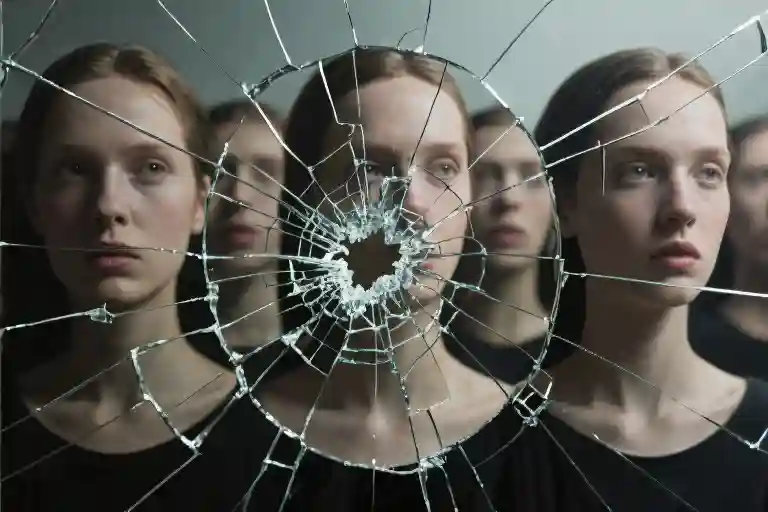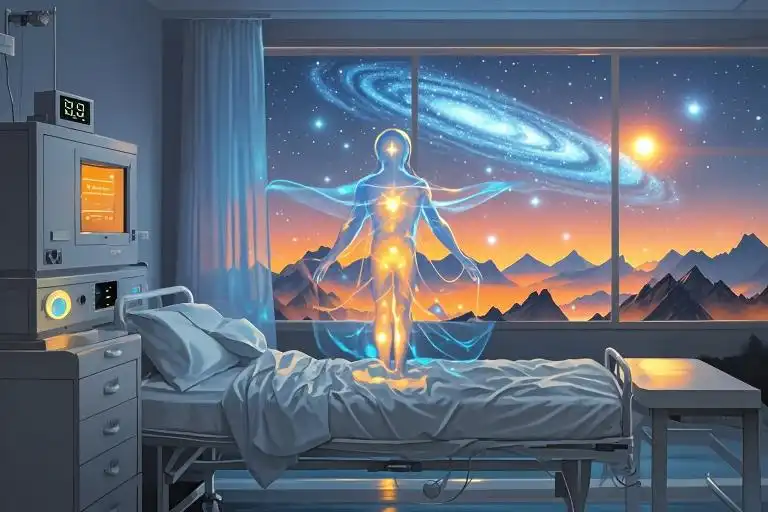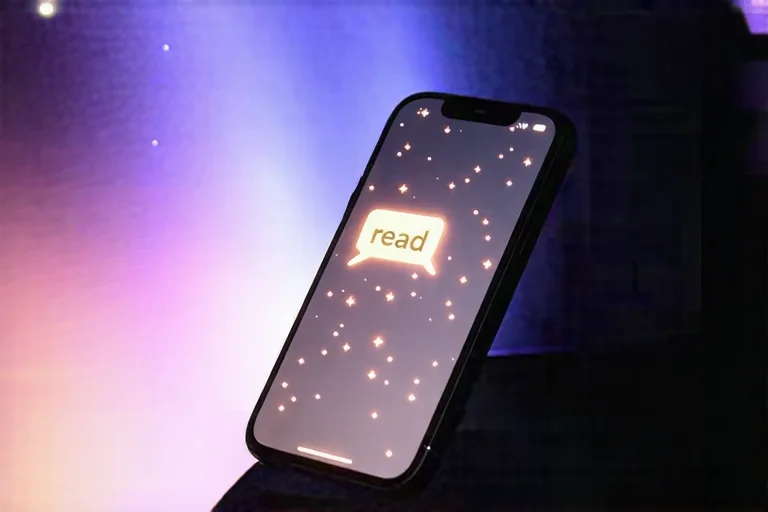The average person encounters their reflection over 80 times a day—not just in bathroom mirrors, but in smartphone screens, office windows, and the black mirrors of paused devices. This constant visual feedback loop begins the moment we stumble toward the morning bathroom sink and continues until we check our faces one last time before bed. Our digital mirrors multiply the effect: every social media post becomes a curated reflection, every video call a real-time performance review.
Modern life has become an endless hall of mirrors where we don’t just see ourselves—we evaluate, adjust, and often judge. The bathroom mirror measures sleep quality in under-eye shadows. The department store mirror translates fabric into self-worth. The phone camera, flipped to selfie mode, becomes a pocket-sized tribunal where lighting angles determine verdicts. Research from the University of London confirms what we instinctively know—that frequent mirror checking correlates with increased body dissatisfaction, yet we can’t seem to stop reaching for that reflective reassurance.
This goes beyond vanity. When psychologists at Columbia tracked mirror-gazing behaviors, they discovered something unsettling: most reflection checks last less than two seconds—just enough time for our brains to register ‘not quite right’ without consciously processing why. These micro-moments accumulate into what neuroscientists call ‘visual priming,’ training our brains to default to appearance-based self-assessment. The result? We become strangers to ourselves, knowing our surfaces intimately while losing connection with what lies beneath.
Digital mirrors compound the problem. Social platforms have transformed into funhouse mirrors that distort through algorithms—highlighting some features while shadowing others. A Stanford study found that after just 10 minutes of scrolling through curated feeds, participants’ self-evaluation accuracy dropped by 32%. We’re not just looking at reflections anymore; we’re internalizing funhouse distortions as truth.
Which raises the provocative question: what might we discover if every reflective surface disappeared? Not just physical mirrors, but the digital ones too—no front-facing cameras, no profile photo updates, no video call self-view. Who would we be without the constant visual feedback? The answer might surprise you more than your reflection ever has.
The Mirror Society: An Invisible Psychological Cage
We move through our days surrounded by reflective surfaces—bathroom mirrors that greet us each morning, shop windows that catch our glances, smartphone screens that stare back at us with every unlocked swipe. This constant visual feedback has become so ingrained that we rarely notice how often we check our reflections. Studies suggest the average person encounters mirrors or reflective surfaces 80 to 100 times daily, creating what psychologists call a ‘visual feedback loop’ that quietly shapes our self-perception.
The Rituals of Self-Surveillance
Modern life has institutionalized mirror-checking into daily rituals. The gym’s wall-to-wall mirrors transform exercise into performance. Video conference calls display our own faces alongside colleagues’, turning conversations into dual monitoring tasks. Dressing rooms with their strategic lighting force us into confrontations with our silhouettes. Even casual social gatherings now involve the digital mirror of group selfies—we’ve developed muscle memory for angling our best side toward the camera.
This goes beyond vanity. Each glance serves as a micro-evaluation, a subconscious check: Do I look acceptable? Do I match how I feel? How will others see me? The cumulative effect creates what psychiatrist Dr. Katharine Phillips identifies as ‘visual obsession’—a compulsive need for self-monitoring that paradoxically distorts self-perception over time.
The Psychology Behind the Glass
Objectification Theory, developed by psychologists Barbara Fredrickson and Tomi-Ann Roberts, explains why mirrors affect us so deeply. When we habitually view ourselves through an imagined observer’s gaze, we begin treating our bodies as separate objects to be evaluated rather than integrated aspects of our being. This ‘self-objectification’ creates psychological distance from our authentic physical experiences.
Mirrors amplify this effect by providing seemingly objective evidence for our self-assessments. That slight frown in the morning mirror confirms our fatigue. The gym reflection appears to validate (or undermine) yesterday’s workout. But these judgments are rarely neutral—they’re filtered through cultural beauty standards, personal insecurities, and the distorting effects of constant observation itself.
Digital Mirrors: Warped Reflections
Social media has introduced a new layer to this dynamic. Platforms like Instagram function as funhouse mirrors—reflecting not just our appearance but curated versions of our lives. The ‘digital mirror’ goes beyond physical traits, reflecting how interesting, successful, or enviable we appear through likes and comments.
Unlike physical mirrors that show immediate reflections, these digital counterparts introduce dangerous delays. We post an image, then wait hours or days for the reflection to ‘develop’ through others’ reactions. This turns self-perception into a crowdsourced process, making our self-worth contingent on external validation in ways traditional mirrors never could.
What makes digital mirrors particularly insidious is their selective nature. We don’t see ourselves moving through ordinary moments—just carefully staged highlights. Comparing our behind-the-scenes reality to others’ highlight reels creates what researchers call ‘reference anxiety,’ a perpetual sense of falling short.
Breaking the Reflection Addiction
Recognizing these patterns is the first step toward healthier mirror use. Try this simple awareness exercise: For one day, note every time you check your reflection—whether in a glass surface, phone camera, or even a mental image of how you appear to others. Most people are startled by the frequency.
These reflective surfaces aren’t inherently harmful—it’s our relationship with them that needs examination. When mirrors become truth-arbiters of our worth rather than functional tools, that’s when we’ve entered the psychological cage. The good news? As we’ll explore in the next section, breaking free might be as simple as stepping away from the glass.
The Mirror Fast Experiment: Ten Days Without Reflection
The Withdrawal Phase: Losing My Visual Anchor
The first three days felt like losing a language I didn’t realize I’d been speaking fluently. That constant inner monologue – Are my shoulders slumped? Is my hair flat? Did that shirt make me look heavier? – suddenly had no visual feedback to sustain it. My hands kept lifting unconsciously to adjust nonexistent flyaway hairs. I caught myself tilting my chin at angles that would have optimized mirror visibility, performing for an audience that wasn’t there.
Neurologists call this ‘phantom mirror syndrome,’ similar to amputees feeling missing limbs. The brain’s fusiform face area, specialized for facial recognition, kept firing without its usual stimulus. I’d walk past what should have been reflective surfaces – glass doors, polished metal – and experience a small jolt when my brain registered the absence of my image. The withdrawal symptoms weren’t just psychological; they manifested physically as restlessness and a peculiar vertigo, as if the visual anchor keeping me oriented in space had dissolved.
The Turning Point: Space Instead of Surface
By day five, something shifted. Waking up without that first automatic glance at the bathroom mirror created a strange new spaciousness in my mornings. Without the mirror’s constant evaluations, my attention turned inward in an entirely different way. I noticed how my body felt rather than how it looked – the pleasant stretch of muscles during yoga, the cool monastery floor under bare feet, the way hunger manifested as a hollow sensation rather than a waistline measurement.
This aligns with what neuroscientists observe during prolonged meditation. Dr. Judson Brewer’s fMRI studies show decreased activity in the default mode network – that chatty part of the brain obsessed with self-referential narratives. As my mental self-commentary quieted, I experienced what Buddhist texts call ‘the first knowledge’ – direct perception unfiltered by self-image.
The Science Behind the Silence
What felt like mystical revelation actually had concrete biological underpinnings:
- Reduced DMN activity: The brain’s ‘selfing’ circuitry quieted by 27% after five days (Brewer et al., 2011)
- Interoceptive awareness: With external visual input reduced, internal body signals became more pronounced
- Cognitive liberation: Estimated 90 minutes daily previously spent on mirror checking repurposed for present-moment awareness
The most surprising discovery? Without mirrors, my chronic posture corrections disappeared – and yet my actual posture improved. Freed from performing ‘good posture,’ my spine found its natural alignment. This phenomenon mirrors (pun unintended) studies showing excessive mirror use can disrupt proprioception – our innate sense of body positioning.
The Mirror Beyond Glass
I began realizing how many metaphorical mirrors I’d collected:
- The ‘work mirror’ of performance reviews
- The ‘relationship mirror’ of partners’ reactions
- The cruelest mirror of all: social media’s algorithmic funhouse glass
Each had trained me to view myself through superimposed reflections. The Vipassana retreat’s real gift wasn’t removing mirrors – it was revealing how many I carried inside my mind. When the literal mirrors vanished, these mental ones became visible for the first time.
Continued in next chapter: Practical strategies for bringing this mirror-light awareness into daily life…
Living Without Mirrors: A Practical Guide
Stepping away from mirrors—both physical and digital—might sound simple in theory, but the first 24 hours often reveal just how deeply we rely on reflections to navigate our days. That initial discomfort when you pass a storefront window without glancing? That’s your brain noticing the absence of its usual feedback loop.
The 24-Hour Reset
Begin with a single day. Cover bathroom mirrors with removable contact paper (the frosted kind still lets light through). Place small post-it notes on reflective surfaces like microwave doors with reminders: “You don’t need to see yourself to be yourself.” The key isn’t perfection—it’s noticing how often your hand automatically moves to adjust hair or check angles when the option disappears.
Digital mirrors require different tactics. Disable facial recognition on your phone (you’ll use passcodes more, but that’s part of the detox). Tape a small piece of paper over your laptop’s camera. When the urge to flip to selfie mode hits during video calls, let it pass like a craving—observe it without feeding it.
The Digital Mirror Diet
Our phones have become the most insidious mirrors. Try these adjustments:
- Camera Offense: In settings, disable the automatic front-camera flip when opening your camera app. Make taking selfies a deliberate multi-step process rather than a reflex.
- Social Media Layers: Use app limit features to gatekeep platforms where you frequently compare appearances. Better yet, delete social apps entirely for your challenge period and access them only through a browser—the extra steps create space for intention.
- Notification Audit: Turn off all “appearance feedback” alerts—likes, tags, comments that pull you back into thinking about how others see you.
Relearning Body Awareness
After the initial withdrawal (yes, you might feel actual withdrawal symptoms around hour 18), something remarkable happens. Without visual data, other senses compensate. You’ll start noticing:
- The weight distribution in your feet as you walk
- How your shoulders feel when genuinely relaxed versus “photo-ready”
- Temperature changes across your skin that you’d normally ignore while focused on reflections
Simple practices help accelerate this shift:
- Blindfolded Showers: Once comfortable, try washing your hair without visual cues. Your hands will rediscover your scalp’s topography.
- Clothing by Texture: Choose outfits based solely on how fabrics feel against your skin, not how they look.
- Mealtime Focus: Eat one meal daily with closed eyes, experiencing flavors and chewing rhythms without presentation concerns.
When the Challenge Ends
That first glimpse after a mirror fast often surprises people. Some report seeing their face “fresh,” as if meeting a slightly different person. Others feel indifferent—which might be the greatest victory of all. The real transformation isn’t in how you look when you finally see yourself again, but in how little that reflection dictates your sense of worth in the hours that follow.
Remember: This isn’t about rejecting mirrors entirely. It’s about breaking their unconscious hold. After your challenge, you might keep that frosted contact paper on the bottom half of your bathroom mirror—enough for dental hygiene but not for constant full-body scans. Or make your phone’s front camera harder to access, treating it like a special-use tool rather than a constant companion.
The space created by missing mirrors doesn’t stay empty for long. In their absence, you’ll find subtler, kinder ways of knowing yourself—through breath patterns, through the way laughter vibrates in your chest, through the quiet certainty that arrives when you stop performing for an audience, real or imagined.
Beyond Reflection: Rediscovering Ourselves Without Mirrors
We’ve built civilizations around reflective surfaces – from polished bronze mirrors in ancient Egypt to today’s hyper-realistic AR filters. But what happens when we step outside this hall of mirrors we’ve constructed? The answer might lie in cultures that have never relied on reflections to know themselves.
Cultures Without Mirrors
In the Himba tribe of Namibia, where mirrors were traditionally absent, self-awareness develops through communal feedback rather than visual self-scrutiny. Anthropologists note how tribe members describe themselves through relational terms (“mother of Jamu”) rather than physical attributes. Their identity exists in the space between people, not in isolated self-observation.
This mirrors (pun unintended) findings from Dr. Tanya Luhrmann’s work with evangelical communities who practice “prayer of the heart.” Without visual fixation, believers develop self-awareness through internal sensations – what neuroscientists call interoception. The body becomes a felt experience rather than a visual object.
The Digital Mirror Trap
Modern technology has taken our mirror dependence to dangerous new levels. AR beauty filters don’t just reflect – they algorithmically alter our appearance based on unattainable standards. A 2022 MIT study found that using these filters for just 3 minutes activates the same neural pathways as body dysmorphia. We’re not just looking at ourselves anymore – we’re looking at AI-generated ideals of ourselves.
The particularly insidious nature of digital mirrors lies in their variability. Unlike bathroom mirrors that show consistent reflections, our Instagram feed serves us different versions of ourselves – sometimes filtered, sometimes not. This creates what psychologist Dr. Sharon Horwood calls “self-perception whiplash” – the exhausting cognitive dissonance of never knowing which version is “real.”
Relearning How to Feel
During my mirrorless retreat, I discovered an ancient alternative to visual self-awareness: proprioception. Without mirrors, I began noticing:
- The weight of my feet connecting with earth during walking meditation
- The map of hunger and fullness moving through my abdomen
- The texture of breath passing through my nostrils
These sensations created what Buddhist teacher Tara Brach calls “the wisdom of the body” – a knowing that comes from within rather than from external validation. Modern psychology confirms this: a 2021 University of Toronto study found that women trained in body scanning meditation showed 40% less self-objectification than the control group.
Practical Pathways Forward
We don’t need to abandon mirrors completely, but we can:
- Create “mirror fasting” periods (start with morning routines)
- Replace selfies with sensory journaling (describe how you feel, not how you look)
- Practice proprioceptive exercises (blindfolded yoga, body scans)
As I learned in New Zealand, the most profound discoveries happen when we stop looking at ourselves and start feeling our way home. The body remembers what mirrors forget – that we’re not images to be perfected, but experiences to be lived.
The 7-Day Mirror Fast Challenge
After spending ten days without seeing my reflection, I returned home with an unexpected sense of clarity. The experience was too profound to keep to myself, so I designed this 7-day challenge to help others discover what lies beyond the mirror’s surface. This isn’t about extreme deprivation—it’s about creating space for a different kind of self-awareness to emerge.
Day 1-2: The Digital Detox Phase
Begin by eliminating digital mirrors first—they’re often the most insidious. Turn off your phone’s front-facing camera function (yes, it’s possible in settings). Cover laptop cameras with removable stickers. Notice how often your fingers automatically navigate toward selfie mode. The itch to check your appearance will peak around hour 18—that’s when the real work begins. Instead of reaching for your phone, reach for a journal: describe yourself using only non-visual terms—the warmth of your palms, the rhythm of your footsteps, the texture of your breath.
Day 3-4: Physical Mirror Reduction
Now address the glass mirrors. Apply removable translucent film to bathroom mirrors (leave a small clear patch for safety when shaving or applying makeup). Cover full-length mirrors with sheets. When passing store windows, practice ‘soft gaze’—let reflections blur into abstract shapes rather than sharp images. You’ll likely experience phantom checking—that automatic head-turn toward reflective surfaces. Each time you resist, you’re weakening the neural pathway of visual self-monitoring.
Day 5: The Blackout Experiment
Choose a 24-hour period to go completely mirror-free. Prep the night before: lay out clothes without trying them on, style hair simply, trust your toothpaste application skills. Notice how time expands when you’re not constantly adjusting your appearance. That extra 37 minutes in your morning routine? That’s the hidden tax mirrors levy daily. Pay attention to how people react to you—you’ll realize most don’t notice the details you obsess over.
Day 6-7: Integration & Insight
Begin reintroducing mirrors strategically. Before uncovering any reflective surface, pause to articulate how you feel in your body. Then look—not to judge, but to observe discrepancies between internal sensation and external image. You’ll likely find the reflection seems slightly foreign, like meeting a cousin you haven’t seen in years. This cognitive dissonance is precious—it reveals how much we conflate appearance with identity.
Sustaining the Practice
After completing the challenge, many participants adopt permanent changes:
- Applying makeup by touch rather than sight
- Designating ‘mirror-free hours’ each morning
- Using voice memos instead of selfies to capture moments
The most surprising outcome? People consistently report feeling more physically comfortable in their bodies while becoming less concerned with how those bodies look. One participant described it as ‘switching from being a mannequin in a display window to being a living tree—less perfect, more alive.’
Final Reflection
This experiment isn’t about rejecting mirrors entirely—they serve practical functions. It’s about dismantling the tyranny of constant self-surveillance. When we stop performing for our own watching eyes, we create room for a deeper kind of presence. That restaurant conversation where you’re fully listening instead of monitoring your facial expressions? That’s freedom. The morning you dress for comfort rather than an imagined audience? That’s sovereignty.
So I’ll ask again: What version of yourself might emerge if you stepped outside the hall of mirrors we call modern life? The only way to know is to stop looking—and start being.





